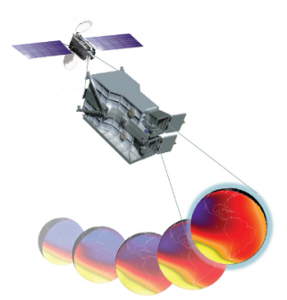
NASA has announced that LASP will collaborate on a $55 million project to build and launch an instrument to provide unprecedented imaging of the Earth’s upper atmosphere from a geostationary orbit.
The information collected by the Global-scale Observations of the Limb and Disk (GOLD) mission will have a direct impact on understanding space weather and its impact on communication and navigation satellites, which we’ve come to rely on for everything from television programming to cell phone coverage and GPS in our vehicles.
The GOLD project is part of NASA’s Explorer Program, designed to provide frequent, low-cost access to space for heliophysics and astrophysics missions with small to mid-sized spacecraft. The mission is a collaboration between LASP, the University of Central Florida (UCF), and the commercial satellite company, SES Government Solutions.
In addition to providing the compact instrument, which is roughly the size of a microwave oven, LASP will provide project management, systems engineering, safety and mission assurance, instrument operations, and Education and Public Outreach (E/PO) for the mission. Under the leadership of GOLD Principal Investigator Richard Eastes, UCF will oversee the project, and build the data center that will collect, process, and distribute the science data for the mission. SES is scheduled to launch it on one of its communication satellites in 2017. GOLD’s collaborative approach may blaze a trail for similar projects at universities nationwide.
According to Mark Lankton, senior professional research assistant at LASP and GOLD project manager, “An important aspect of the mission is that GOLD will be one of the first NASA science missions to fly as a hosted payload on a commercial communications satellite. This is by far the most cost-effective way to put a science instrument into geostationary orbit, where it can observe nearly a full hemisphere of the Earth all of the time.”
The scientific goals of the GOLD mission are to determine how geomagnetic storms alter the temperature and composition of Earth’s atmosphere, to analyze the global-scale response of the thermosphere to solar extreme-ultraviolet variability, to investigate the significance of atmospheric waves and tides propagating from below the temperature structure of the thermosphere and to resolve how the structure of the equatorial ionosphere influences the formation and evolution of equatorial plasma density irregularities.
“GOLD’s imaging represents a new paradigm for observing the boundary between Earth and space,” said Bill McClintock, senior research scientist at LASP and GOLD Deputy Principal Investigator. “It will revolutionize our understanding of how the sun and the space environment affect our upper atmosphere.”
Other members of the GOLD team that will be supporting the mission include the National Center for Atmospheric Research, the University of California at Berkeley, Computational Physics, Inc. and the National Oceanic and Atmospheric Administration.
Contact
LASP/CU-Boulder:
- Bill McClintock, GOLD Deputy Principal Investigator: 303-492-8407 or Bill.McClintock@lasp.colorado.edu
- Mark Lankton, GOLD Program Manager: 303-492-7905 or Mark.Lankton@colorado.edu
- Stephanie Renfrow, LASP Office of Communications and Outreach: 303-735-5814 or Stephanie.Renfrow@lasp.colorado.edu
CU-Boulder:
- Jim Scott, CU media relations: 303-492-3114 or Jim.Scott@colorado.edu
University of Central Florida:
- Zenaida Gonzalez Kotala, UCF News & Information: 407-823-6120 or zenaida.kotala@ucf.edu
[addthis]



